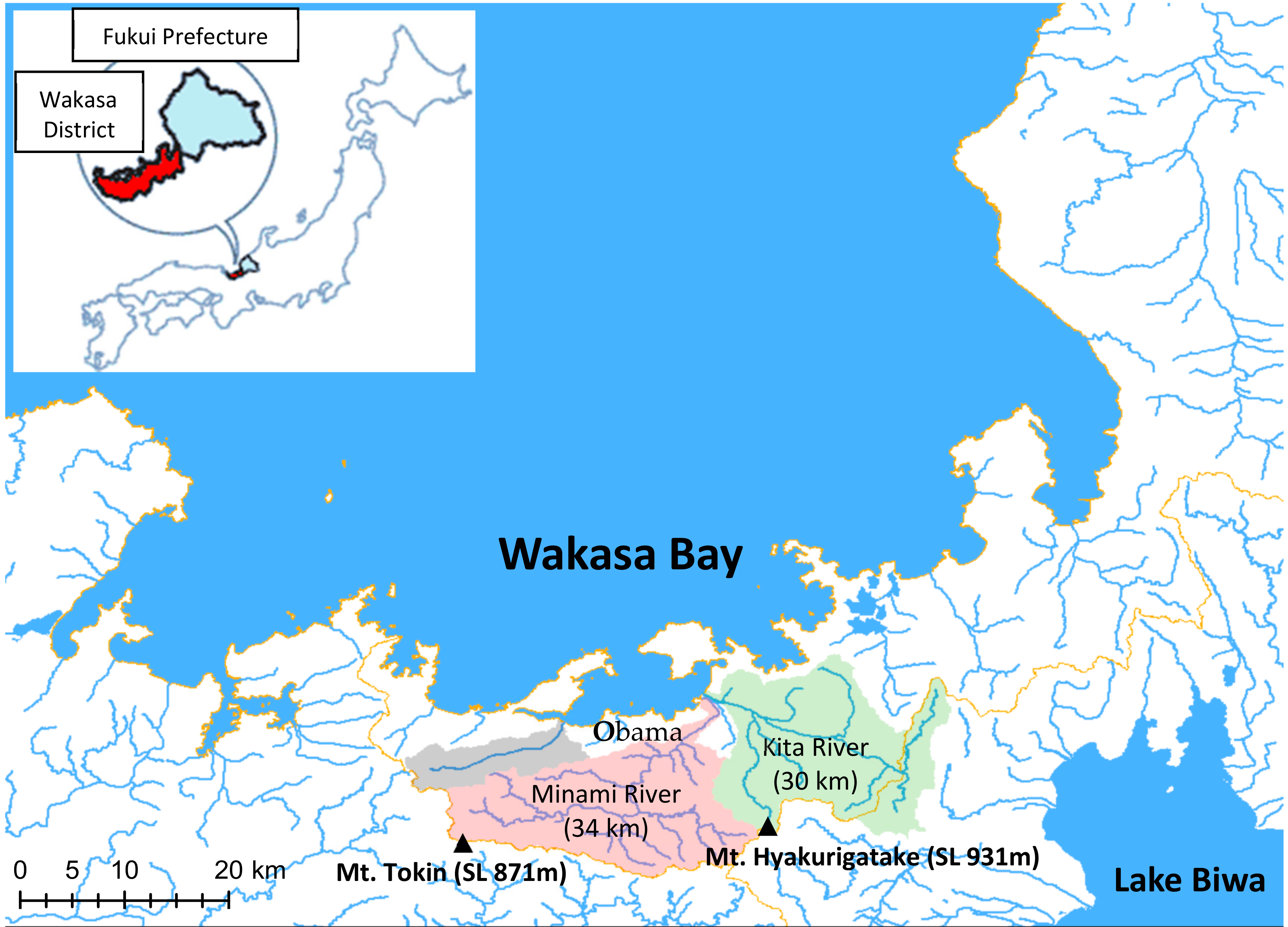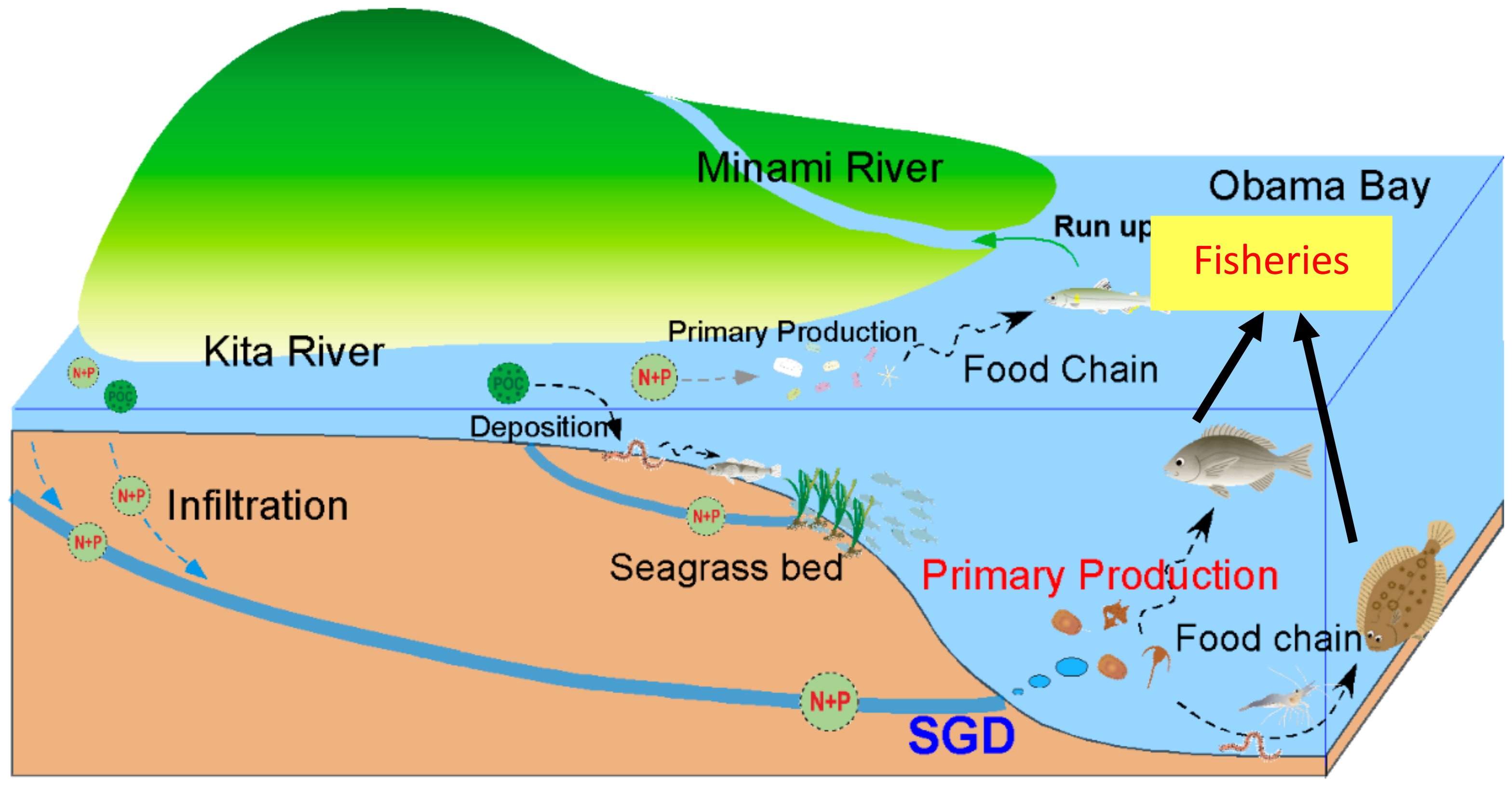Evaluating the Tradeoffs between Groundwater Pumping for Snow-Melting and Nearshore Fishery Productivity in Obama City, Japan
Abstract
:1. Introduction
2. Methods
2.1. History of Groundwater Use in Obama City
2.2. Avoided Cost of Groundwater Alternatives for Melting Snow
2.3. Cost of Groundwater for Melting Snow
2.4. Nearshore Fishery Production Losses
3. Results
3.1. Avoided Cost of Groundwater Alternatives for Melting Snow
3.2. Cost of Groundwater for Melting Snow
3.3. Nearshore Fishery Production Losses
4. Discussion
5. Conclusions
Author Contributions
Funding
Conflicts of Interest
References
- Japanese Ministry of Land, Infrastructure, Transport and Tourism. Current State of Water Resources in Japan; 2008. Available online: http://www.mlit.go.jp/tochimizushigen/mizsei/water_resources (accessed on 1 February 2018).
- The Report of Economic Evaluation Research on the Project of Human-Environmental Security in Asia-Pacific Ring of Fire: Water-Energy-Food Nexus. Research Institute for Natural Capital, Co., Ltd.: Tokyo, Japan, 2014.
- Intergovernmental Panel on Climate Change (IPCC). The Regional Impacts of Climate Change: An Assessment of Vulnerability; Cambridge University Press: Cambridge, UK, 1997; p. 517. [Google Scholar]
- Organization for Economic Co-operation and Development (OECD). Water and Climate Change Adaptation: Policies to Navigate Uncharted Waters; OECD Studies on Water; OECD Publishing: Paris, France, 2013. [Google Scholar]
- Gemma, M.; Tsur, Y. The Stabilization Value of Groundwater and Conjunctive Water Management under Uncertainty. Appl. Econ. Perspect. Policy 2007, 29, 540–548. [Google Scholar] [CrossRef]
- Tsur, Y.; Graham-Tomasi, T. The buffer value of groundwater with stochastic surface water supplies. J. Environ. Manag. 1991, 21, 201–224. [Google Scholar] [CrossRef]
- Brown, J.; Bach, L.; Aldous, A.; Wyers, A.; De Gagné, J. Groundwater-dependent ecosystems in Oregon: An assessment of their distribution and associated threats. Front. Ecol. Environ. 2011, 9, 97–102. [Google Scholar] [CrossRef]
- Howard, J.; Merrifield, M. Mapping Groundwater Dependent Ecosystems in California. PLoS ONE 2010, 5, e11249. [Google Scholar] [CrossRef] [PubMed]
- Moosdorf, N.; Oehler, T. Societal use of fresh submarine groundwater discharge: An overlooked water resource. Earth-Sci. Rev. 2017, 171, 338–348. [Google Scholar] [CrossRef]
- Moya, T.; Boulton, A.J. Ecology and management of subsurface groundwater dependent ecosystems in Australia—A review. Mar. Freshw. Res. 2010, 61, 936–949. [Google Scholar]
- Murray, B.R.; Zeppel, M.J.B.; Hose, G.C.; Eamus, D. Groundwater-dependent ecosystems in Australia: It’s more than just water for rivers. Ecol. Manag. Restor. 2003, 4, 110–113. [Google Scholar] [CrossRef]
- MacKay, H. Protection and management of groundwater-dependent ecosystems: Emerging challenges and potential approaches for policy and management. Aust. J. Bot. 2006, 54, 231–237. [Google Scholar] [CrossRef]
- Burnett, K.; Pongkijvorasin, S.; Roumasset, J.; Wada, C.A. Incentivizing interdependent resource management: Watersheds, groundwater, and coastal ecology. In Handbook of Water Economics; Dinar, A., Schwabe, K., Eds.; Edward Edgar Publishing: Cheltenham/Northampton, UK, 2015; pp. 150–161. [Google Scholar]
- Foster, S.; Koundouri, P.; Tuinhof, A.; Kemper, K.; Nanni, M.; Garduno, H. Groundwater Dependent Ecosystems: The Challenge of Balanced Assessment and Adequate Conservation; GW Mate Briefing Note Series No. 15; World Bank: Washington, DC, USA, 2006. [Google Scholar]
- Rohde, M.M.; Froend, R.; Howard, J. A Global Synthesis of Managing Groundwater Dependent Ecosystems under Sustainable Groundwater Policy. Groundwater 2017, 55, 293–301. [Google Scholar] [CrossRef] [PubMed]
- Burnett, K.; Wada, C.; Endo, A.; Taniguchi, M. The economic value of groundwater in Obama. J. Hydrol. Reg. Stud. 2017, 11, 44–52. [Google Scholar] [CrossRef]
- Konikow, L.F.; Kendy, E. Groundwater depletion: A global problem. Hydrogeol. J. 2005, 13, 317–320. [Google Scholar] [CrossRef]
- Final Report of Groundwater Investigation in Obama. Nippon Koei Co., Ltd.: Tokyo, Japan, 2016.
- Lalli, C.M.; Parsons, T.R. Biological Oceanography: An Introduction, 2nd ed.; Elsevier: Burlington, MA, USA, 1997; 306p, ISBN 978-0-7506-3384-0. [Google Scholar]
- Dadhich, A.P.; Nadaoka, K.; Motomura, Y.; Watanabe, A. Potential impacts of land use change dynamics and submarine groundwater discharge on fringing reefs of Kuroshima Island, Japan. J. Coast. Conserv. 2017, 21, 245–254. [Google Scholar] [CrossRef]
- Piló, D.; Barbosa, A.B.; Teodósio, M.A.; Encarnação, J.; Leitão, F.; Range, P.; Krug, L.A.; Cruz, J.; Chícharo, L. Are submarine groundwater discharges affecting the structure and physiological status of rocky intertidal communities? Mar. Environ. Res. 2018, 136, 158–173. [Google Scholar] [CrossRef] [PubMed]
- Shoji, J.; Tominaga, O. Relationships between Submarine Groundwater Discharge and Coastal Fisheries as a Water-Food Nexus. In The Water-Energy-Food Nexus—Global Environmental Studies; Endo, A., Oh, T., Eds.; Springer: Singapore, 2018; pp. 117–131. [Google Scholar]
- Main Fish Catch Landed in Obama Market; Obama Branch of the Fishery Association of Fukui Prefecture: Fukui, Japan, December 2017.
- Fishery Management Statistics; Ministry of Agriculture, Forestry, and Fisheries of Japan: Tokyo, Japan, 2015.
- Water Supply and Sewerage Costs; Obama City Office: Fukui, Japan, 2018.
- Sugimoto, R.; Honda, H.; Kobayashi, S.; Takao, Y.; Tahara, D.; Tominaga, O.; Taniguchi, M. Seasonal Changes in Submarine Groundwater Discharge and Associated Nutrient Transport into a Tideless Semi-enclosed Embayment (Obama Bay, Japan). Estuaries Coasts 2016, 39, 13–26. [Google Scholar] [CrossRef]
- Tominaga, O.; Makita, T. Contribution of terrestrial organic matter to benthic bioproduction in coastal areas. In Linkage of Forests, Rivers and Coasts and Biological Production in Estuarine and Coastal Waters; Yamashita, Y., Tanaka, M., Eds.; Koseisha-Koseikaku: Tokyo, Japan, 2008; pp. 46–58. [Google Scholar]
- Hata, M.; Sugimoto, R.; Hori, M.; Tomiyama, T.; Shoji, J. Occurrence, distribution and prey items of juvenile marbled sole Pseudopleuronectes yokohamae around a submarine groundwater seepage on a tidal flat in southwestern Japan. J. Sea Res. 2016, 111, 47–53. [Google Scholar] [CrossRef]



| Technology | 15 Snow Days | 29 Snow Days |
|---|---|---|
| Manual (retired) | 180.0 | 348.0 |
| Manual (market) | 291.6 | 563.8 |
| Heat pump | 19.4 | 37.6 |
| Oil | 38.9 | 75.2 |
| Air pump | 48.2 | 101.2 |
| Gas | 52.3 | 183.7 |
| Filament | 95.0 | 93.3 |
| Groundwater | 8.2 | 15.8 |
| Fish Species (English Name) | Fish Species (Japanese Name) | Catch (kg) | Unit Price (JPY/kg) | Proportion of Total Catch |
|---|---|---|---|---|
| Yellowtail | Buri | 1759 | 1238 | 0.02 |
| Young yellowtail | Hamachi | 1406 | 341 | 0.02 |
| Spanish mackerel | Sawara | 3876 | 959 | 0.05 |
| Young Spanish mackerel | Sagoshi | 10,104 | 529 | 0.13 |
| Horse mackerel | Maaji | 3258 | 441 | 0.04 |
| Anchovy | Katakuchiiwashi | 2562 | 31 | 0.03 |
| Flounder | Hirame | 1164 | 1699 | 0.02 |
| Red flounder | Akagarei | 4598 | 720 | 0.06 |
| Willow flounder | Yanagimushigarei | 3666 | 1518 | 0.05 |
| Souhachi flounder | Souhachi | 3934 | 398 | 0.05 |
| Red seabream | Madai | 3645 | 665 | 0.05 |
| Yellowback seabream | Kidai | 10,358 | 549 | 0.14 |
| Red tilefish | Akaamadai | 2769 | 2767 | 0.04 |
| John Dory | Matoudai | 1104 | 897 | 0.01 |
| Monkfish | Ankou | 1264 | 659 | 0.02 |
| Barracuda | Kamasu | 2702 | 446 | 0.04 |
| Filefish | Kawahagi | 2300 | 455 | 0.03 |
| Conger eel | Anago | 1737 | 988 | 0.02 |
| Sandfish | Hatahata | 31 | 677 | 0.00 |
| Octopus | Tako | 1348 | 1329 | 0.02 |
| Snow crab | Zuwaigani | 1039 | 4834 | 0.01 |
| Snow crab (female) | Seikogani | 1434 | 3732 | 0.02 |
| Pacific oyster | Magaki | 1848 | 1017 | 0.02 |
| Sea cucumber | Namako | 498 | 1727 | 0.01 |
| Other | 8210 | 1323 | 0.11 |
| Ship Size | Variable | Capital | Total | Variable Per Ton | Total Per Ton |
|---|---|---|---|---|---|
| <3 tons | 2465 | 4127 | 6592 | 822 | 2197 |
| 3–5 tons | 4661 | 6149 | 10,810 | 932 | 2162 |
| 5–10 tons | 11,542 | 11,962 | 23,504 | 1154 | 2350 |
| 15 Snow Days | |||||||
| Manual (Retired) | Manual (Market) | Heat Pump | Oil | Gas | Filament | Air Pump | |
| Low fishing cost | 171.5 | 283.1 | 10.9 | 30.3 | 43.8 | 86.5 | 39.7 |
| High fishing cost | 171.6 | 283.2 | 11.1 | 30.5 | 43.9 | 86.7 | 39.9 |
| 29 Snow Days | |||||||
| Manual (Retired) | Manual (Market) | Heat Pump | Oil | Gas | Filament | Air Pump | |
| Low fishing cost | 331.8 | 547.6 | 21.4 | 59.0 | 85.0 | 167.6 | 77.1 |
| High fishing cost | 332.0 | 547.7 | 21.6 | 59.1 | 85.1 | 167.7 | 77.2 |
© 2018 by the authors. Licensee MDPI, Basel, Switzerland. This article is an open access article distributed under the terms and conditions of the Creative Commons Attribution (CC BY) license (http://creativecommons.org/licenses/by/4.0/).
Share and Cite
Burnett, K.M.; Wada, C.A.; Taniguchi, M.; Sugimoto, R.; Tahara, D. Evaluating the Tradeoffs between Groundwater Pumping for Snow-Melting and Nearshore Fishery Productivity in Obama City, Japan. Water 2018, 10, 1556. https://doi.org/10.3390/w10111556
Burnett KM, Wada CA, Taniguchi M, Sugimoto R, Tahara D. Evaluating the Tradeoffs between Groundwater Pumping for Snow-Melting and Nearshore Fishery Productivity in Obama City, Japan. Water. 2018; 10(11):1556. https://doi.org/10.3390/w10111556
Chicago/Turabian StyleBurnett, Kimberly M., Christopher A. Wada, Makoto Taniguchi, Ryo Sugimoto, and Daisuke Tahara. 2018. "Evaluating the Tradeoffs between Groundwater Pumping for Snow-Melting and Nearshore Fishery Productivity in Obama City, Japan" Water 10, no. 11: 1556. https://doi.org/10.3390/w10111556
APA StyleBurnett, K. M., Wada, C. A., Taniguchi, M., Sugimoto, R., & Tahara, D. (2018). Evaluating the Tradeoffs between Groundwater Pumping for Snow-Melting and Nearshore Fishery Productivity in Obama City, Japan. Water, 10(11), 1556. https://doi.org/10.3390/w10111556





